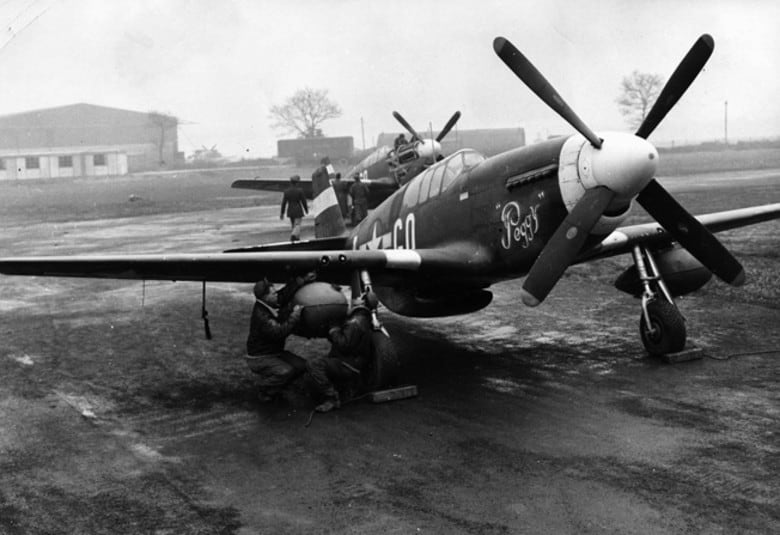
Two P-51D Mustangs at an English airfield in early 1944. The ground crew is fitting the second of two underwing fuel tanks, which allowed the Mustangs to escort American strategic bombers to their targets inside Germany, engage German fighters and return to their bases in England. (U.S. Air Force photo). For more details, click here.
By: Phil Kohn. Dedicated to the memory of his father, GM3 Walter Kohn, U.S. Navy Armed Guard, USNR, and all men and women who have answered the country’s call in time of need. Phil can be contacted at ww2remembered@yahoo.com.
As the climax of the Allies’ “Big Week” bombing campaign, 830 bombers of the U.S. 8th Air Force and 150 bombers of the U.S. 15th Air Force conduct a daylight raid on the Messerschmitt works at Regensburg and at Augsburg on February 25, 1944. Losing a total of 65 planes themselves, the Americans claim to shoot down 142 German fighters as well as destroying 1,000 German fighters on the assembly lines and 1,000 more in lost production. In Reykjavik, the Icelandic Parliament declares the island’s independence from Denmark.
The Allies’ “Big Week” bombing campaign of German industrial cities — deemed a success by planners — comes to an official conclusion on February 26. On the Eastern Front, the Soviet 54th Army captures Porkhov, Russia, about 50 miles from the Estonian border. In six weeks, the Red Army has inflicted tremendous damage on German Army Group North, wiping out three divisions, routing 17 more and capturing 189 tanks and 1,800 artillery pieces. In addition, local partisans have killed over 21,000 German troops, destroyed 300 bridges and derailed 136 German military trains. Some 600 Soviet bombers attack Helsinki, Finland — fires started by the raid can be seen from 250 miles away. In South America, the source of the Orinoco River is discovered near the Brazilian-Venezuelan border by the crew of a U.S. Army Air Forces plane flying a patrol out of British Guiana.
U.S. military authorities report on February 27 that about 60,000 Japanese are trapped on New Britain and New Ireland. These enemy troops will be bypassed.
On February 28, the Admiralty Islands, part of Papua-New Guinea, are invaded by the U.S. Army’s 1st Cavalry Division. This leaves the Japanese Pacific Headquarters at Rabaul, on New Britain in the Bismarck Archipelago, bypassed and isolated. Gen. Douglas MacArthur pays a one-day visit to the Admiralties. Arab governments lodge a protest with the U.S. regarding sentiments expressed in Congress concerning creation of a Jewish state in Palestine. In Germany, test pilot Hanna Reitsch visits Hitler at Berchtesgaden to receive a second Iron Cross and suggests the establishment of a squadron of suicide bombers who could pilot a modified version of the V-1 rocket. Reitsch volunteers to become a member of such a squadron, but der Führer is not receptive, feeling the war situation does not presently warrant such a unit. He does, however, authorize a research program to explore the idea.
In Italy, the Germans launch a third major offensive at Anzio on February 29 but fail to break through. In southeast Asia, five leaders of the Indonesian Communist Party are sentenced to death by the Japanese.
On March 1, 1944, massive anti-fascist strikes occur in Mussolini’s Italian Social Republic in northern Italy, with as many as 1.2 million workers walking off their jobs. Farther south, Vatican City is bombed a second time, this time by an Italian plane that drops six bombs on the edge of the papal enclave, killing a workman and wounding a seminarian. In Germany, the “Jägerstab (Fighter Staff)” is formed, under Karl-Otto Saur, acting under the authority of the Armaments Ministry led by Albert Speer. Consisting of government officials, SS personnel and representatives of the aircraft industry, the task force’s objective is to boost production of the Me-109 and Fw-190 fighter planes. The group decides that — in the wake of the Allies’ “Big Week” bombing attacks — assembly lines will be located in mines and in tunnels to protect against air raids. After two weeks of heavy fighting, the Germans abandon their attempts to eliminate the Allied beachhead at Anzio.
On March 2, the U.S. government cuts off Lend-Lease aid to Turkey because that nation is reluctant to join the war on the Allied side or to make any other contribution to the Allied war effort. At Balvano, Italy, about 50 miles east of Salerno, a steam-powered freight train stalls inside a tunnel; 521 illegal riders are asphyxiated by smoke and carbon monoxide fumes. (Because of major food shortages, they were headed to farms in the countryside where they could barter goods and commodities given to them by Allied soldiers for fresh produce.) In Yugoslavia, Allied planes conduct their first bombing mission in support of Tito’s Partisan forces, near Knin, Croatia, an important transportation junction between Zagreb and Split.



